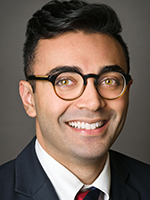Abraar Karan considers a case that made him confront how much is lost or misunderstood in doctor-patient communication

“Why am I here?” Mrs S looked up at me for the first time since I had entered the room and begun speaking to her. I had spent the past five minutes talking about the need for her to start new medications for her heart failure. She had nodded along for most of the conversation, but I wondered if she had heard, or more importantly understood, anything I had been saying. She had had three admissions for heart failure exacerbation in the past few months. And yet, she looked at me and said, “Do I have heart problems? No one ever told me?”
In that moment, I had to ask myself what had gone wrong in her care. Could it actually have been that no one ever told her about the problem with her heart? That seemed unlikely, even for a bunch of overworked doctors. Maybe, I questioned, her diagnosis hadn’t been explained in terms she could understand? Many days, I supervise interns and medical students, and not uncommonly they are entangled in medical language that goes over most patients’ heads. A major learning process for trainees is understanding how best to communicate in so-called laymen’s terms while still sharing all the necessary information.
Although many patients are well informed and knowledgeable about their health, the reality is that a lot of patients have low health literacy—particularly those who are older, from immigrant or minority populations in which English isn’t a first language, or from low income or low educational backgrounds. Estimates suggest that low health literacy, and the failure to address it, cost the US economy anywhere from $100 to 200 billion, annually.
Nonetheless, as her doctor, I felt disappointed—had we as a medical system collectively failed to communicate effectively?
However, what if this was not just about doctors’ ability to communicate the facts of her condition? After discussing the case with other colleagues, some pointed out that communication is only one part of the equation. What if I had missed an important consideration—that Mrs S just wasn’t quite ready to accept her diagnosis? One experienced doctor suggested that I consider the possibility that she was in denial. Denial is a complex coping mechanism—a universal emotion that almost anyone reading this has dealt with—and which may play a much larger part in people’s ability to understand their own illness than we appreciate. One doctor shared her own experience of denial when her father was diagnosed with amyotrophic lateral sclerosis: “In the face of a diagnosis for which there is no effective treatment and no cure, our denial allowed my family six months of relative peace before things became unbearable.”
Was Mrs S coping with her diagnosis in a similar way? Was she aware, in her own mind, that she was possibly nearing the last year or two of her life (repeat heart failure admissions do in fact predict mortality)? I then wondered—maybe it was not a failure to explain on the part of her medical teams, but her own difficulty with acceptance that she was quite sick. And even if she were not in denial, was she perhaps just too overwhelmed by this distressing news to properly process what it meant?
I fear that we don’t always take the time, or are even adequately trained, to figure out what patients do and don’t understand, what they do and do not accept, and what they are and are not able to cope with in that moment. In one study, nearly 40% of hospitalised patients had no understanding regarding their plan of care for the day—and only 32% even remembered the name of one of their doctors (60% could name their nurses, though).
Every day, I give patients dozens of diagnoses, and mostly I am met with silence, nods, and occasionally questions. It would be prudent for me to come back later to check in with my patients and revisit their understanding of what was going on, yet from personal observations and practice I’d say that we as providers rarely do this. Part of this has to do with the unforgiving workflow of the day (simply not having time to go back), but I do think that there is an undiagnosed disconnect between what doctors think their patients understand and what they actually understand. Integrating medical communication as a formal practice of study into medical school curricula would be an important start.
Mrs S said to me that no one had ever told her she had heart issues, and I tried my best to explain further. Yet I couldn’t be entirely sure that she understood, accepted, or even truly wanted me to be explaining this to her in that moment in time. She looked at me, smiled, nodded, and offered a polite, “Thank you.” But in a few weeks or months’ time, will she ask her next doctor the same question, and might they also wonder, as I did, where her previous doctors went wrong?
As much as we must ask how much our patients understand about their illness, we must also ask ourselves how much we understand about our patients. Patients do not always remember what we say, but they will always remember the way we made them feel. We need to do better at knowing what to say, how to say it, and when to say it if we want communication to truly work.
Abraar Karan is an internal medicine resident at the Brigham and Women’s Hospital/ Harvard Medical School. Twitter @AbraarKaran
Competing interests: None declared.
The opinions expressed in this article are solely those of the author and do not reflect the views and opinions of Brigham and Women’s Hospital.
